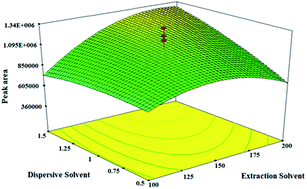Dispersive liquid–liquid microextraction for preconcentration and determination of phenytoin in real samples using response surface methodology-high performance liquid chromatography
Abstract
In the present study, dispersive liquid–liquid microextraction (DLLME) was developed for preconcentration and determination of phenytoin in real samples by high performance liquid chromatography (HPLC). Several experimental variables were investigated such as the extraction solvent, disperser solvent, salt effect, extraction time, centrifuge time, centrifuge speed and sample volume. Firstly, an orthogonal array design (OAD) was applied to choose the significant variables. Then, the significant factors were optimized using the central composite design (CCD). The variables were optimized with the aid of the response surface methodology. Chloroform and ethanol were selected as extraction and dispersive solvents, respectively. In this method, a linear range of 0.01–24 μg mL−1 and the relative standard deviation from 1.7 to 12.35% were obtained for water samples. Also, for urine samples, the linear range of 0.2–24 μg mL−1 and the relative standard deviation from 1.41 to 9.3% were obtained. The limit of detection (LOD) and limit of quantitative (LOQ) were 0.94 and 2.84 and also, 1.63 and 4.94 μg mL−1 for water and urine samples respectively.


 Please wait while we load your content...
Please wait while we load your content...